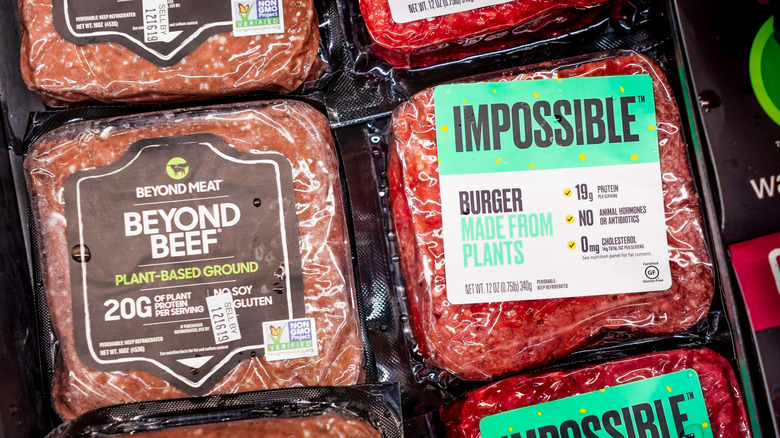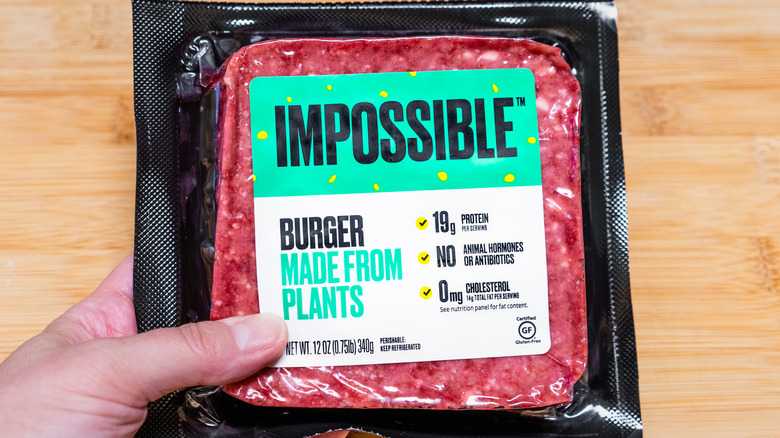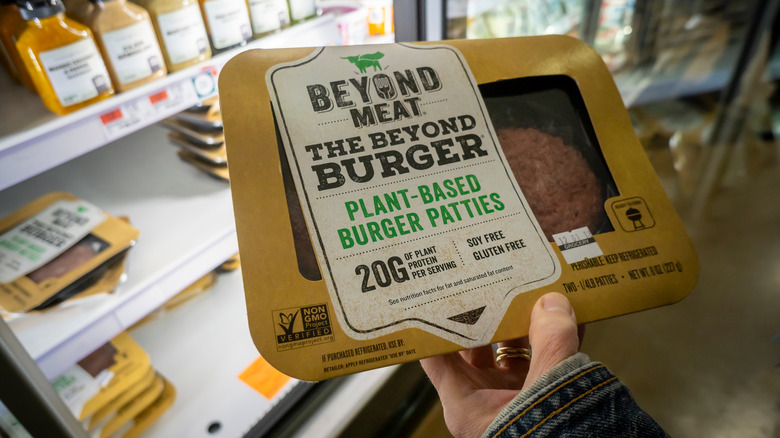What's The Difference Between An Impossible Burger And A Beyond Burger?
Plant-based foods are becoming more and more common in grocery stores and restaurants, and two big companies we can thank for that are Impossible Foods and Beyond Meat. Impossible Foods was officially founded by Dr. Patrick Brown on July 16, 2011, and has its headquarters in Redwood City, California. Dr. Brown was a professor at Stanford University and was on a sabbatical in 2009 when he felt compelled to do something about climate change. So he left his job and set out on his new journey. Brown specifically wanted to focus on how he could reduce our carbon footprint by making the food we eat better for our environment. To create Impossible Foods, Dr. Brown worked with scientists to "analyze meat at the molecular level and determine precisely why meat looks, cooks and tastes the way it does," per the company's website.
According to The New York Times, Beyond Meat was created in 2009 by Ethan Brown and taken public in 2019. His inspiration for starting Beyond Meat is similar to Dr. Brown's because he also wanted to address the climate crisis and create foods that were more sustainable for the environment. However, Mr. Brown's love for animals as well as his adherence to a vegetarian turned vegan diet since he was in high school, were also some personal reasons for starting his own brand of meatless products. While the two companies have similar products and inspirations, there are a few differences between the products themselves.
Impossible Burger is made with soy protein
According to Impossible Foods, the main protein source in an Impossible burger is soy protein concentrate and isolate. To emulate the way real meat sizzles on a grill, the patties use sunflower and coconut oils as the fat. Impossible burgers are also made with natural flavors, water, cultured dextrose, yeast extract, soy leghemoglobin, modified food starch, methylcellulose, salt, L-tryptophan, and tocopherols, which are antioxidants. Methylcellulose and food starch help bind the patties together and allow them to be easily formed into kebabs, meatballs, meatloaves, and more. To give the patties a meaty flavor, Impossible Foods uses a molecule called heme that can be found in soy leghemoglobin, which comes from soy roots (via Impossible Foods). Impossible burgers are completely vegan and gluten-free, but they should be avoided by anyone with a soy allergy.
As far as nutrition goes, one 4-ounce Impossible burger patty has 230 calories, 12 grams of fat, 9 grams of carbohydrates, 370 milligrams of sodium, and 19 grams of protein. Each patty also contains 180 milligrams of calcium, 4.2 milligrams of iron, 700 milligrams of potassium, thiamin (vitamin B1), riboflavin (vitamin B2), niacin, zinc, phosphorus, vitamins B6 and B12, and folate.
Beyond Burger is made with pea and rice proteins
In contrast, the protein in Beyond burgers is a combination of pea and rice protein. For fat, Beyond Meat uses refined coconut oil, cocoa butter, and expeller-pressed canola oil so that patties sizzle when cooked (via Beyond Meat), similar to the Impossible burger. Beyond patties are also made with water, natural flavors, dried yeast, methylcellulose, potato starch, salt, potassium chloride, vinegar, sunflower lecithin, beet juice, apple juice, and pomegranate concentrate for color. Beyond burgers are vegan, gluten-free, and a good choice for anyone with a soy allergy since they are soy-free. However, anyone with a peanut or other legume allergy should avoid eating Beyond burgers since they are made with pea protein.
Both Impossible and Beyond patties are fairly similar in terms of nutrition. One 4-ounce Beyond burger has 230 calories, 14 grams of fat, 7 grams of carbohydrates, 390 milligrams of sodium, and 20 grams of protein. Each patty also has 100 milligrams of calcium, 4 milligrams of iron, 330 milligrams of potassium, niacin, vitamins B6 and B12, and zinc.


